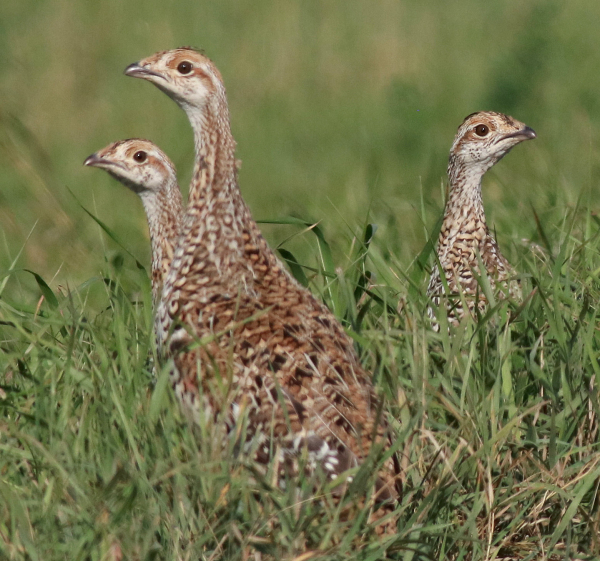
Protecting and managing grasslands to capture more carbon will also mean that grassland-dependent birds, like these young Sharp-tailed Grouse, have adequate year-round habitat (photo by Paul Konrad).
|
A new report from the National Audubon Society shows that habitats that are important for birds now and in the future are also critical for reducing greenhouse emissions given their ability to naturally store and sequester carbon. This means that maintaining and restoring these landscapes through incentives for management and conservation are important strategies in our collective challenge to stabilize climate change.
“Birds are showing us that both their survival and ours depends on ecosystems with the ability to filter our air and water in key landscapes around the country,” said Sarah Greenberger, senior vice president for conservation at the National Audubon Society. “The scale of climate change has disrupted these natural processes, but with the right incentives for management, our forests, grasslands, wetlands, and urban green spaces can play a role in reducing harmful emissions while protecting birds.”
Audubon researchers studied ecosystems across the country that are critical to both carbon storage and to birds, and found that these regions often overlapped. Combined, the priority areas studied already store more than 100 billion tons of carbon and, if climate-smart strategies are implemented, they have the potential to sequester up to twice as much carbon annually as they do currently. The report found that by conserving, managing, and restoring these priority areas, the United States. could realize up to 23 percent of its Paris Agreement commitment to reduce emissions.
“Our previous research showed that what’s good for birds when it comes to addressing climate change is also good for the communities they share their habitats with,” said Brooke Bateman, director of climate science at Audubon and one of the authors of the report. “The priority areas highlighted in this report have the added benefit of being prime natural climate solutions. Management of these areas to draw down emissions while simultaneously supporting efforts that help both birds and people is a win-win-win.”
Much of the land in priority areas is privately owned, so while management of public lands will play an important part, policies must also respect the role that landowners and producers play in maximizing the conservation and climate mitigation potential of the nation’s key landscapes.
“Working with private landowners and incentivizing voluntary climate-smart practices can increase resilience to climate change, drive investments into local communities, and help protect some of the country’s most important habitats for birds,” said Melinda Cep, vice president of natural solutions and working lands at Audubon. “Public lands also present ample opportunities to maintain and restore natural climate solutions and create a cleaner future for all.”
The report authors identified the following ecosystems as beneficial both to bird habitat and natural carbon storage:
Forests: Currently, forests keep more carbon out of the atmosphere than any other habitats, especially in Alaska. The report identifies 538 million acres of priority forests. Natural forest management, avoided forest conversion, and reforestation are 3 of the most e?ective ways to store carbon, and forests also support the greatest diversity of nesting birds across the country.
Grasslands: More than 333 million acres of grasslands represent priority areas to maintain, and more than 243 million acres of degraded grasslands represent priority areas to restore. By maintaining existing grasslands, restoring native prairies, and supporting conservation-focused ranching, we can capture a considerable amount of atmospheric carbon. And because some grassland birds are among the most threatened in North America, restoring grasslands to capture more carbon will also mean that grassland-dependent birds have a more promising future.
Wetlands: Including coastal and interior freshwater and saline wetlands, these priority areas provide critical nesting habitat for many species, and capture and store carbon at a high rate per acre. The analysis identified nearly 25 million acres of priority coastal wetland habitats. While degradation and conversion of wetland habitats can release carbon dioxide into the atmosphere, management and restoration can allow these areas to become effective carbon sinks.
Urban Green Spaces: Well-maintained green spaces in cities and suburban areas have a role to play too, by providing birdscapes for migratory and local bird species, along with critical outdoor space for millions of people. They can also help keep air clean, cool down cities, and manage urban ?ooding. More than 38 million acres of urban and suburban systems represent priority areas to maintain, and more than 55 million acres of degraded urban and suburban systems represent priority areas to restore.
The report also contains policy recommendations to not only maintain, manage, and restore these ecosystems, but to encourage innovation and research. Although natural climate solutions can help meet emissions reduction goals to avoid the worst impacts of climate change, investments must also be made to de-carbonize every sector of our economy, including electricity production, transportation, and industry.
“We must trust the science and take action to support natural solutions to climate change for the benefit of both people and wildlife,” said Greenberger. “From cleaner air for all urban communities, to voluntary programs that will help private landowners, to ensuring that traditional and Indigenous land stewards have a say in the decision-making process – our policies must reflect equity, fairness, and respect for everyone.”
To refer to the original Audubon article, see https://www.audubon.org/news/audubon-report-shows-important-bird-habitats-are-key-natural-solutions-climate